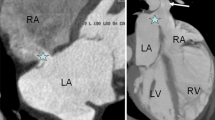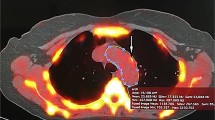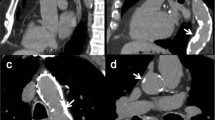Abstract
We explored the impact of gender and cardiovascular risk factors (RF) in the distribution and burden of coronary and extra-coronary atherosclerotic plaques among patients undergoing ECG-gated thoracoabdominal computed tomography angiography (CTA) from the supra-aortic trunks to the femoral arteries. We included a consecutive cohort of patients who underwent ECG-gated thoracoabdominal aortic CTA from the supra-aortic trunks to the pubic symphysis. We evaluated the number of coronary segments with plaques [segment-involvement score (SIS)]; and the extra-coronary atherosclerotic plaque burden, comprising the aorta and supra-aortic trunks, iliofemoral arteries, and visceral arteries (extra-coronary SS). A total of 3400 vascular segments were evaluated in 100 patients (mean age 67.0 ± 12.6 years, 66% male). Seventy-two (72%) patients had evidence of atherosclerosis in the coronary tree (coronary SIS ≥ 1), of which 32% was extensive (coronary SIS > 5). Males had a significantly higher prevalence of coronary SIS ≥ 1 [53 (80%), vs. 19 (56%), p = 0.018], and coronary SIS > 5 [24 (36%) vs. 8 (24%), p = 0.035] than females. Extra-coronary SS was similar between genders (males 10.2 ± 5.8 vs. females 9.7 ± 5.4, p = 0.70), irrespective of the location along the different vascular beds. The number of coronary RF was significantly related to the coronary SIS (p = 0.038), and hypertension and diabetes were consistently related to coronary and extra-coronary plaque burden. In the present study involving analysis of multiple vascular beds from the supra-aortic trunks to the femoral arteries, we identified significant sex-related differences in coronary plaque burden, whereas extra-coronary plaque burden was similar between genders irrespective of the vascular bed assessed.




Similar content being viewed by others
References
Sutton-Tyrrell K, Kuller LH, Matthews KA et al (2002) Subclinical atherosclerosis in multiple vascular beds: an index of atherosclerotic burden evaluated in postmenopausal women. Atherosclerosis 160(2):407–416
Rodriguez-Granillo GA, Garcia-Garcia HM, Wentzel J et al (2006) Plaque composition and its relationship with acknowledged shear stress patterns in coronary arteries. J Am Coll Cardiol 47(4):884–885
Winkel LC, Hoogendoorn A, Xing R, Wentzel JJ, Van der Heiden K (2015) Animal models of surgically manipulated flow velocities to study shear stress-induced atherosclerosis. Atherosclerosis 241(1):100–110
Craiem D, Alsac JM, Casciaro ME et al (2016) Association between thoracic aorta calcium and thoracic aorta geometry in a cohort of asymptomatic participants at increased cardiovascular risk. Rev Esp Cardiol (Engl Ed) 69(9):827–835
Wentzel JJ, Corti R, Fayad ZA et al (2005) Does shear stress modulate both plaque progression and regression in the thoracic aorta? Human study using serial magnetic resonance imaging. J Am Coll Cardiol 45(6):846–854
Otaki Y, Gransar H, Cheng VY et al (2015) Gender differences in the prevalence, severity, and composition of coronary artery disease in the young: a study of 1635 individuals undergoing coronary CT angiography from the prospective, multinational confirm registry. Eur Heart J Cardiovasc Imaging 16(5):490–499
Matthews KA, Crawford SL, Chae CU et al (2009) Are changes in cardiovascular disease risk factors in midlife women due to chronological aging or to the menopausal transition? J Am Coll Cardiol 54(25):2366–2373
Liyanage L, Lee NJ, Cook T et al (2016) The impact of gender on cardiovascular system calcification in very elderly patients with severe aortic stenosis. Int J Cardiovasc Imaging 32(1):173–179
Rodriguez-Granillo GA, Reynoso E, Capunay C, Carpio J, Carrascosa P (2018) Pericardial and visceral, but not total body fat, are related to global coronary and extra-coronary atherosclerotic plaque burden. Int J Cardiol 260:204–210
Min JK, Shaw LJ, Devereux RB et al (2007) Prognostic value of multidetector coronary computed tomographic angiography for prediction of all-cause mortality. J Am Coll Cardiol 50(12):1161–1170
Hadamitzky M, Achenbach S, Al-Mallah M et al (2013) Optimized prognostic score for coronary computed tomographic angiography: results from the CONFIRM registry (COronary CT Angiography EvaluatioN For Clinical Outcomes: An InteRnational Multicenter Registry). J Am Coll Cardiol 62(5):468–476
Harloff A, Simon J, Brendecke S et al (2010) Complex plaques in the proximal descending aorta: an underestimated embolic source of stroke. Stroke 41(6):1145–1150
Fernandez-Friera L, Penalvo JL, Fernandez-Ortiz A et al (2015) Prevalence, vascular distribution, and multiterritorial extent of subclinical atherosclerosis in a middle-aged cohort: the PESA (Progression of Early Subclinical Atherosclerosis) study. Circulation 131(24):2104–2113
Laclaustra M, Casasnovas JA, Fernandez-Ortiz A et al (2016) Femoral and carotid subclinical atherosclerosis association with risk factors and coronary calcium: the AWHS study. J Am Coll Cardiol 67(11):1263–1274
Allam AHA, Thompson RC, Eskander MA et al (2017) Is coronary calcium scoring too late? Total body arterial calcium burden in patients without known CAD and normal MPI. J Nucl Cardiol. https://doi.org/10.1007/s12350-017-0925-9
Stampfer MJ, Colditz GA, Willett WC et al (1991) Postmenopausal estrogen therapy and cardiovascular disease. Ten-year follow-up from the nurses’ health study. N Engl J Med 325(11):756–762
Virmani R, Kolodgie FD, Burke AP, Farb A, Schwartz SM (2000) Lessons from sudden coronary death: a comprehensive morphological classification scheme for atherosclerotic lesions. Arterioscler Thromb Vasc Biol 20(5):1262–1275
Ouriel K (2001) Peripheral arterial disease. Lancet 358(9289):1257–1264
Duprez DA, Jacobs DR Jr, Lutsey PL et al (2009) Race/ethnic and sex differences in large and small artery elasticity–results of the multi-ethnic study of atherosclerosis (MESA). Ethn Dis 19(3):243–250
Valgimigli M, Rodriguez-Granillo GA, Garcia-Garcia HM et al (2006) Distance from the ostium as an independent determinant of coronary plaque composition in vivo: an intravascular ultrasound study based radiofrequency data analysis in humans. Eur Heart J 27(6):655–663
O’Donnell CJ, Cupples LA, D’Agostino RB et al (2007) Genome-wide association study for subclinical atherosclerosis in major arterial territories in the NHLBI’s Framingham Heart Study. BMC Med Genet 8(Suppl 1):S4
Bennet AM, Di Angelantonio E, Ye Z et al (2007) Association of apolipoprotein E genotypes with lipid levels and coronary risk. JAMA 298(11):1300–1311
Rodriguez-Granillo GA, Carrascosa P, Deviggiano A et al (2017) Pericardial fat volume is related to atherosclerotic plaque burden rather than to lesion severity. Eur Heart J Cardiovasc Imaging 18(7):795–801
Ladeiras-Lopes R, Sampaio F, Bettencourt N et al (2017) The ratio between visceral and subcutaneous abdominal fat assessed by computed tomography is an independent predictor of mortality and cardiac events. Rev Esp Cardiol (Engl Ed) 70(5):331–337
Bouchi R, Takeuchi T, Akihisa M et al (2015) High visceral fat with low subcutaneous fat accumulation as a determinant of atherosclerosis in patients with type 2 diabetes. Cardiovasc Diabetol 14:136
Rodriguez-Granillo GA, Reynoso E, Capunay C, Antoniades C, Shaw LJ, Carrascosa P (2018) Prognostic value of vascular calcifications and regional fat depots derived from conventional chest computed tomography. J Thorac Imaging. https://doi.org/10.1097/RTI.0000000000000370
Hong HC, Hwang SY, Park S et al (2015) Implications of pericardial, visceral and subcutaneous adipose tissue on vascular inflammation measured using 18FDG-PET/CT. PloS ONE 10(8):e0135294
Oikonomou EK, Marwan M, Desai MY et al (2018) Non-invasive detection of coronary inflammation using computed tomography and prediction of residual cardiovascular risk (the CRISP CT study): a post-hoc analysis of prospective outcome data. Lancet 392(10151):929–939
Antonopoulos AS, Oikonomou EK, Antoniades C, Tousoulis D (2016) From the BMI paradox to the obesity paradox: the obesity-mortality association in coronary heart disease. Obes Rev 17(10):989–1000
Ravnskov U, Diamond DM, Hama R et al (2016) Lack of an association or an inverse association between low-density-lipoprotein cholesterol and mortality in the elderly: a systematic review. BMJ Open 6(6):e010401
Houslay ES, Cowell SJ, Prescott RJ et al (2006) Progressive coronary calcification despite intensive lipid-lowering treatment: a randomised controlled trial. Heart 92(9):1207–1212
Rodriguez-Granillo GA, Carrascosa P, Bruining N (2016) Progression of coronary artery calcification at the crossroads: sign of progression or stabilization of coronary atherosclerosis? Cardiovasc Diagn Ther 6(3):250–258
Bittencourt MS, Hulten E, Ghoshhajra B et al (2014) Prognostic value of nonobstructive and obstructive coronary artery disease detected by coronary computed tomography angiography to identify cardiovascular events. Circ Cardiovasc Imaging 7(2):282–291
Hadamitzky M, Taubert S, Deseive S et al (2013) Prognostic value of coronary computed tomography angiography during 5 years of follow-up in patients with suspected coronary artery disease. Eur Heart J 34(42):3277–3285
Author information
Authors and Affiliations
Corresponding author
Ethics declarations
Conflict of interest
We declare that Dr. Patricia Carrascosa is consultant of GE Healthcare. There are no competing interests related to the manuscript for any of the other authors.
Ethical approval
The protocol was approved by the institutional ethics committee and all studies have been performed in accordance with the ethical standards as laid down in the 1975 Declaration of Helsinki and its later amendments.
Informed consent
Informed consent was obtained from all individual participants included in the study.
Electronic supplementary material
Below is the link to the electronic supplementary material.
Rights and permissions
About this article
Cite this article
Rodriguez-Granillo, G.A., Campisi, R., Reynoso, E. et al. Atherosclerotic plaque burden evaluated from neck to groin: effect of gender and cardiovascular risk factors. Int J Cardiovasc Imaging 35, 907–915 (2019). https://doi.org/10.1007/s10554-018-1512-0
Received:
Accepted:
Published:
Issue Date:
DOI: https://doi.org/10.1007/s10554-018-1512-0




